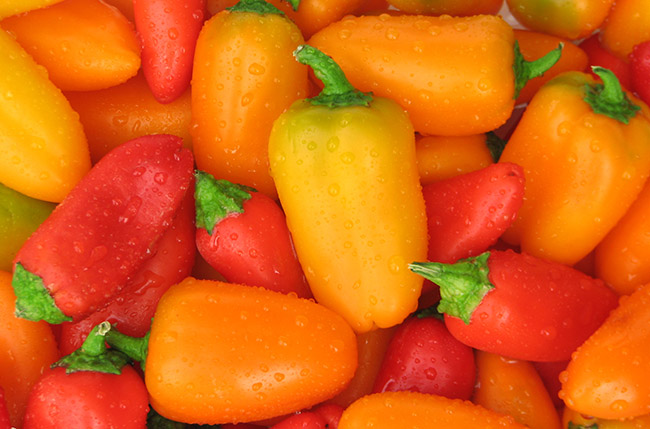
Organic mini sweet peppers are closely related to the traditional bell pepper, but they are much smaller and have a sweeter flavor and crunchier texture. These peppers are typically available in vibrant yellows, oranges, and reds. Mini sweet peppers are a relatively new variety of the Capsicum anuum, first commercially produced in the 1990s. They were bred specifically to have the sweet and crunchy aspects of the bell pepper in a small, manageable package. One of the convenient aspects of the mini sweet pepper is that they are almost completely seedless, which saves time during preparation. Unlike many of its spicy relatives, the mini sweet pepper does not have any heat, it does not register on the Scoville scale at all because it does not produce any capsaicin.
Mini sweet peppers can be used in any application that would normally call for bell peppers. These mini peppers work well as a sweet, crunchy topping for things like salad and pizza. They become succulent, juicy and even sweeter when grilled or sautéed and used in dishes like fajitas. Stuffing these little peppers is a very common use for them. Stuffing the pepper with a little meat, rice and cheese, and grilling or baking them makes a delicious side dish. Wonderful appetizers can be made with mini sweet peppers by stuffing them with cream cheese and baking them. Mini sweet peppers are the perfect size for grilled kebabs. They can even be eaten plain and raw for a fresh, sweet snack. These peppers are the perfect addition to any fresh veggie plate. Cutting a raw mini sweet pepper in half lengthwise makes it perfect for dipping in fresh dips like salsa, guacamole and hummus.
Fresh mini sweet peppers have firm, smooth skin with a waxy sheen. It will be firm to the touch. The peppers should be stored in a plastic bag in the refrigerator and will stay fresh for just over a week. They can be thinly sliced, or chopped and then frozen, and will last about a year. When the skin of the pepper become soft to the touch, and loses its shine and becomes wrinkly, the pepper is no longer fresh and should not be used. When preparing the pepper, begin by rinsing the pepper, then removing the stem by cutting off the cap of the pepper. Check for seeds, because there will sometimes be a few, and remove them all before using the pepper. The seeds of this pepper can be quite hard and fibrous, so it’s best to ensure none of them end up being eaten.


 BACK TO PRODUCTS
BACK TO PRODUCTS